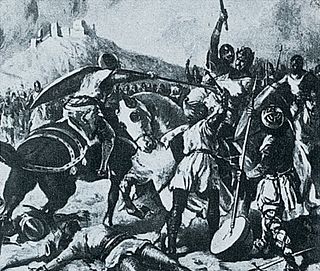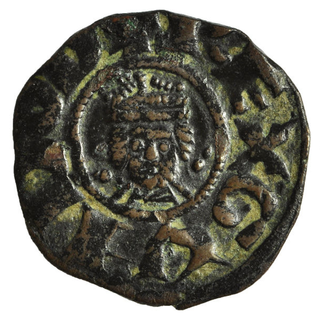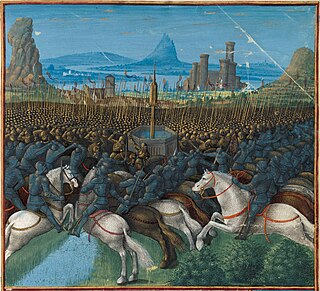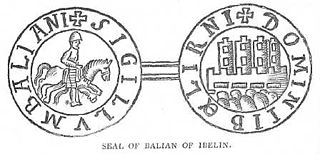Related Research Articles

Aimery of Lusignan, erroneously referred to as Amalric in earlier scholarship, was the first king of Cyprus, reigning from 1196 to his death in 1205. He also reigned as the king of Jerusalem from his marriage to Queen Isabella I in 1197 to his death. He was a younger son of Hugh VIII of Lusignan, a nobleman in Poitou. After participating in a rebellion against Henry II of England in 1168, he went to the Holy Land and settled in the Kingdom of Jerusalem.
Year 1130 (MCXXX) was a common year starting on Wednesday of the Julian calendar.

Year 1124 (MCXXIV) was a leap year starting on Tuesday of the Julian calendar, the 1124th year of the Common Era (CE) and Anno Domini (AD) designations, the 124th year of the 2nd millennium, the 24th year of the 12th century, and the 5th year of the 1120s decade.
The 1180s was a decade of the Julian Calendar which began on January 1, 1180, and ended on December 31, 1189.

Year 1213 (MCCXIII) was a common year starting on Tuesday of the Julian calendar.
Year 1177 (MCLXXVII) was a common year starting on Saturday of the Julian calendar.
Year 1183 (MCLXXXIII) was a common year starting on Saturday of the Julian calendar.
Year 1267 (MCCLXVII) was a common year starting on Saturday of the Julian calendar.

William of Tyre was a medieval prelate and chronicler. As archbishop of Tyre, he is sometimes known as William II to distinguish him from his predecessor, William I, the Englishman, a former prior of the Church of the Holy Sepulchre, who was Archbishop of Tyre from 1127 to 1135. He grew up in Jerusalem at the height of the Kingdom of Jerusalem, which had been established in 1099 after the First Crusade, and he spent twenty years studying the liberal arts and canon law in the universities of Europe.

Guy of Lusignan was King of Jerusalem, first as husband and co-ruler of Queen Sibylla from 1186 to 1190 then as disputed ruler from 1190 to 1192. He was also Lord of Cyprus from 1192 to 1194.

Ta Prohm is the modern name of a temple near the city of Siem Reap, Cambodia, approximately one kilometre east of Angkor Thom and on the southern edge of the East Baray. It was built in the Bayon style largely in the late 12th century and early 13th century and was originally called Rajavihara. It was founded by the Khmer King Jayavarman VII as a Mahayana Buddhist monastery and center of learning dedicated to his mother. Almost 80,000 people were required to maintain or attend at the temple, including over 2,700 officials and 615 dancers.

Jayavarman VII, known posthumously as Mahaparamasaugata, was king of the Khmer Empire. He was the son of King Dharanindravarman II and Queen Sri Jayarajacudamani. He was the first king devoted to Buddhism, as only one prior Khmer king had been a Buddhist. He then built the Bayon as a monument to Buddhism. Jayavarman VII is generally considered the most powerful of the Khmer monarchs by historians. His government built many projects including hospitals, highways, rest houses, and temples. With Buddhism as his motivation, King Jayavarman VII is credited with introducing a welfare state that served the physical and spiritual needs of the Khmer people.

The Battle of Cresson was a small battle between Frankish and Ayyubid forces on 1 May 1187 at the "Spring of the Cresson." While the exact location of the spring is unknown, it is located in the environs of Nazareth. The conflict was a prelude to the decisive defeat of the Kingdom of Jerusalem at the Battle of Hattin two months later.
Barisan of Ibelin was the first lord of Ibelin and the founder of the House of Ibelin in the crusader Kingdom of Jerusalem. His name was later written as "Balian" and he is sometimes known as Balian the Elder, Barisan the Old or Balian I. Barisan was also lord of Ramla from 1138 to 1150.
Baldwin of Ibelin, also known as Baldwin II of Ramla, was an important noble of the Kingdom of Jerusalem in the 12th century and was lord of Ramla from 1169-1186. He was the second son of Barisan of Ibelin, and was the younger brother of Hugh of Ibelin and older brother of Balian of Ibelin. He first appears in the historical record as a witness to charters in 1148.

Balian of Ibelin, also known as Barisan the Younger, was a crusader noble of the Kingdom of Jerusalem in the 12th century. He was Lord of Ibelin from 1170 to 1193. As the leader of the defense of the city during the siege of Jerusalem in 1187, he surrendered Jerusalem to Saladin on 2 October 1187.
Ernoul was a squire of Balian of Ibelin who wrote an eyewitness account of the fall of Jerusalem in 1187. This was later incorporated into an Old French history of Crusader Palestine now known as the Chronicle of Ernoul and Bernard the Treasurer, often abbreviated Ernoul-Bernard. The chronicle covers the years from 1100 until 1228. A few manuscripts copied for Bernard, treasurer of Corbie Abbey, extend the narrative down to 1232.
The Lordship of Tyre was a semi-independent domain in the Kingdom of Jerusalem from 1246 to 1291.

The Estoire d'Eracles is an anonymous Old French translation and continuation of the Latin History of Deeds Done Beyond the Sea by William of Tyre. It begins with recapture of Jerusalem by the Roman emperor Heraclius in AD 630, from which it takes its name, and continues down to 1184. The continuation recounts the history of the Crusader states from Saladin's capture of Jerusalem in 1187 down to 1277.

The portrait of Jayavarman VII is a stone bust carved in Angkor during the late 12th or early 13th century representing Jayavarman VII and currently conserved at the Guimet Museum in Paris. It is one of the landmarks of the aesthetics of the Bayon style.
References
- ↑ Huffman, Joseph Patrick (2009) [2000]. The Social Politics of Medieval Diplomacy: Anglo-German Relations (1066-1307). Studies in Medieval and Early Modern Civilization. Ann Arbor, MI: University of Michigan Press. p. 121. ISBN 9780472024186.
- ↑ Jackson, Guida M.; Jackson-Laufer, Guida Myrl (1999). Women Rulers Throughout the Ages: An Illustrated Guide. Santa Barbara, CA, Denver, CO and Oxford: ABC-CLIO. p. 106. ISBN 9781576070918.
- ↑ Heng, Geraldine (2014). "An African Saint in Medieval Europe: The Black St Maurice and the Enigma of Racial Sanctity". Saints and Race: Marked Flesh, Holy Flesh, ed. Vincent William Lloyd and Molly Harbour Bassett. Routledge. pp. 24–25. OCLC 890090517 – via Academia.edu.
- ↑ Devonshire Association for the Advancement of Science, Literature and Art (1877). Report and Transactions - The Devonshire Association for the Advancement of Science, Literature and Art. Vol. IX: Kingsbridge, July 1877. Plymouth, UK: W. Brendon & Son. p. 107.
- ↑ Stubbs, William (2012). Gesta Regis Henrici Secundi Benedicti Abbatis. The Chronicle of the Reigns of Henry II and Richard I, AD 1169-1192: Known Commonly Under the Name of Benedict of Peterborough. Cambridge Library Collection (in Latin). Vol. I. Cambridge and New York: Cambridge University Press. p. 352. ISBN 9781108048750.
- ↑ Gerald, Hannibal Gerald Duncan (1933). Immigration and Assimilation. Boston, New York: D. C. Heath and Company. p. 322. ISBN 9781171863298.
- ↑ Lipson, Ephraim (1960). Europe in the 19th & 20th Centuries (Eighth ed.). New Delhi, Mumbai: Allied Publishers. p. 200. ISBN 9788170231448.
- ↑ Brewer, Keagan; Kane, James (2019). The Conquest of the Holy Land by Ṣalāḥ al-Dīn: A critical edition and translation of the anonymous Libellus de expugnatione Terrae Sanctae per Saladinum. Crusader Texts in Translation. London and New York: Routledge. ISBN 9781351390699.
- ↑ Edbury, Peter W. (1978). "The 'Cartulaire de Manosque': a Grant to the Templars in Latin Syria and a Charter of King Hugh I of Cyprus1". Historical Research. 51 (124): 174–181. doi:10.1111/j.1468-2281.1978.tb01877.x. ISSN 1468-2281.
Joscius was already arch-bishop of Tyre in October 1186, and he died at an unknown date between October 1200 and May 1202
- ↑ Lakshmipriya, T. (2008). "Conservation and Restoration of the Ta Prohm Temple". In D'Ayala, Dina; Fodde, Enrico (eds.). Structural Analysis of Historic Construction: Preserving Safety and Significance, Two Volume Set: Proceedings of the VI International Conference on Structural Analysis of Historic Construction, SAHC08, 2-4 July 2008, Bath, United Kingdom. Boa Raton, London, New York, Leiden: CRC Press. p. 1491. ISBN 9781439828229.
- ↑ Schissler, Eric J. (2009). "An examination of Khmer prayer inside the Ta Prohm complex and its implications for Angkor management policy". CardinalScholar 1.0: 4.
Khmer King Jayavarman VII ordered the construction of Ta Prohm, which was originally named Rajavihara. According to the temple stele, in C.E. 1186 Jayavarman VII dedicated Ta Prohm in his mother's honor.
- ↑ Welch, David J. (March 1989). "Late Prehistoric and Early Historic Exchange Patterns in the Phimai Region, Thailand". Journal of Southeast Asian Studies. 20 (1): 11–26. doi:10.1017/S0022463400019810. ISSN 1474-0680. S2CID 162693851.
The foundation stela at Ta Prohm (AD 1186) recorded the assignment of 3,140 settlements with nearly 80,000 persons to this shrine,
- ↑ Edbury, Peter W. (2017). The Conquest of Jerusalem and the Third Crusade: Sources in Translation. London and New York: Routledge. ISBN 9781351892421.
- ↑ Bauer, S. Wise (2013). The History of the Renaissance World: From the Rediscovery of Aristotle to the Conquest of Constantinople. New York and London: W. W. Norton & Company. p. 165. ISBN 9780393059762.
- ↑ Stanley, Lane-Poole (July 1898). "The Fight That Lost Jerusalem". The Cornhill Magazine . 5 (25): 64.
The child-king, Baldwin V., was dead, and an intrigue had enthroned Sibylla, a daughter of the royal house of Jerusalem, and she had shared her crown with her husband, Guy of Lusignan
- ↑ Riddell, Scott J.; Erlendsson, Egill; Eddudóttir, Sigrún D.; Gísladóttir, Guðrún; Kristjánsdóttir, Steinunn (October 10, 2018). "Pollen, Plague & Protestants: The Medieval Monastery of Þingeyrar (Þingeyraklaustur) in Northern Iceland". Environmental Archaeology. 27 (2): 193–210. doi:10.1080/14614103.2018.1531191. ISSN 1461-4103. S2CID 134309892.
Kirkjubæjarklaustur (AD 1186–1542)
- ↑ Júlíusson, Árni Daníel; Lárusdottir, Birna; Lucas, Gavin; Pálsson, Gísli (2020). "Episcopal Economics". Scandinavian Journal of History. 45: 95–120. doi:10.1080/03468755.2019.1625436. ISSN 0346-8755. S2CID 214087718.
The nunnery of Kirkjubæjarklaustur in Southeast Iceland was, according to received scholarship, one of the oldest monasteries in Iceland, established in 1186
- ↑ Fabian, Bernhard (2001). Handbuch deutscher historischen Buchbestände. St.Petersburg-Rußland (in German). Hildesheim, Germany: Georg Olms Verlag. p. 24. ISBN 9783487417714.
- ↑ Howard, Michael C. (2012). Transnationalism in Ancient and Medieval Societies: The Role of Cross-Border Trade and Travel. Jefferson, NC: McFarland. p. 82. ISBN 9780786490332.
- ↑ Lee, Lily Xiao Hong; Wiles, Sue (2014). Biographical Dictionary of Chinese Women. Vol. II: Tang Through Ming 618 - 1644. New York and London: Routledge. p. 401. ISBN 9781317515623.
- ↑ Repp, Richard C. (2003). "Review of From the 'Terror of the World' to the 'Sick Man of Europe': European Images of Ottoman Empire and Society from the Sixteenth Century to the Nineteenth". Journal of Islamic Studies. 14 (2): 234–236. doi:10.1093/jis/14.2.234. ISSN 0955-2340. JSTOR 26199607.
- ↑ Eley, Penny (2011). Partonopeus de Blois: Romance in the Making. Cambridge, UK: Boydell & Brewer Ltd. p. 188. ISBN 9781843842743.
- ↑ Tanner, Heather J. (2019). Medieval Elite Women and the Exercise of Power, 1100--1400: Moving Beyond the Exceptionalist Debate. The New Medieval Ages. Cham, Switzerland: Springer. p. 309. ISBN 9783030013462.
- ↑ Asen, Daniel (June 1, 2017). "Song Ci (1186–1249), "Father of World Legal Medicine": History, Science, and Forensic Culture in Contemporary China". East Asian Science, Technology and Society. 11 (2): 185–207. doi:10.1215/18752160-3812294. ISSN 1875-2160. S2CID 152121141.
Song Ci (1186–1249) was an official of the Southern Song Dynasty best known for authoring the Collected Writings on the Washing Away of Wrongs (Xiyuan jilu), a work often hailed as the world's first systematic treatise on forensic medicine.
- ↑ Wang, Zhen'guo; Chen, Ping; Xie, Peiping (1999). History and Development of Traditional Chinese Medicine. Advanced TCM Serie. Vol. I. Beijing, Amsterdam, Tokyo: IOS Press. p. 186. ISBN 9787030065674.
- ↑ Dutelle, Aric W. (2017). An Introduction to Crime Scene Investigation. Burlington. MA: Jones & Bartlett Publishers. pp. 6–7. ISBN 9781284108149.
- ↑ Loud, G. A. (August 1, 2009). "The Chancery and Charters of the Kings of Sicily (1130–1212)". The English Historical Review. CXXIV (509): 779–810. doi:10.1093/ehr/cep182. ISSN 0013-8266.
- ↑ Kleinhenz, Christopher (2004). Medieval Italy: An Encyclopedia. New York and London: Routledge. p. 1167. ISBN 9781135948801.
- ↑ Burns, Ross (2007). Damascus: A History. New York and London: Routledge. p. 172. ISBN 9781134488506.
- ↑ Howlett, Richard (2012). Chronicles of the Reigns of Stephen, Henry II, and Richard I. Cambridge Library Collection (in Latin). Vol. 4. Cambridge and New York: Cambridge University Press. pp. xiv–xv. ISBN 9781108052290.
- ↑ Pohl, Benjamin (2014). "Abbas qui et scriptor? The Handwriting of Robert of Torigni and His Scribal Activity as Abbot of Mont-Saint-Michel (1154–1186)". Traditio. 69: 45–86. doi:10.1017/S0362152900001914. ISSN 0362-1529. S2CID 233356606.
- ↑ Mathieu, Marguerite (January 1, 1966). "Le manuscrit 162 d' Avranches ou Robert de Torigni et Robert Guiscard". Sacris Erudiri. 17 (1): 66–70. doi:10.1484/J.SE.2.304799. ISSN 0771-7776.
- ↑ Mayo, Marlene J.; Rimer, J. Thomas; Kerkham, H. Eleanor (2001). War, Occupation, and Creativity: Japan and East Asia, 1920-1960. Honolulu, HI: University of Hawaii Press. p. 203. ISBN 9780824824334.
- ↑ Frédéric, Louis (2002). Japan Encyclopedia. Cambridge, MA and London: Harvard University Press. p. 636. ISBN 9780674017535.
- ↑ Everard, Judith; Jones, Michael C. E. (1999). "Charters of Geoffrey, Duke of Brittany, Earl of Richmond, 1181 - 1186". The Charters of Duchess Constance of Brittany and Her Family, 1171-1221. Boydell & Brewer. p. 1. ISBN 9780851157511.
- ↑ Everard, J. A. (2004). Brittany and the Angevins: Province and Empire 1158–1203. Cambridge, UK and New York: Cambridge University Press. p. 139. ISBN 9781139426558.
- ↑ Bauer, S. Wise (2013). The History of the Renaissance World: From the Rediscovery of Aristotle to the Conquest of Constantinople. New York: W. W. Norton & Company. p. 160. ISBN 9780393059762.
- ↑ Jacoby, Zehava (January 1, 1979). "The Tomb of Baldwin V, King of Jerusalem (1185-1186), and the Workshop of the Temple Area". Gesta. 18 (2): 3–14. doi:10.2307/766804. ISSN 0016-920X. JSTOR 766804. S2CID 192568024.
Baldwin V, the seventh of the Latin kings of Jerusalem, died in the autumn of 1186 at the age of eight after a rule of about eighteen months
- ↑ Hamilton, Bernard (2005) [2000]. "The Sources for Baldwin IV's Reign". The Leper King and His Heirs: Baldwin IV and the Crusader Kingdom of Jerusalem. Cambridge, UK and New York: Cambridge University Press. p. 6. ISBN 9780521017473.
- ↑ Edbury, Peter W.; Rowe, John Gordon (1990) [1988]. William of Tyre: Historian of the Latin East. Cambridge, UK and New York: Cambridge University Press Archive. p. 22. ISBN 9780521407281.
- ↑ Jackson, W. H. (1994). Chivalry in Twelfth-century Germany: The Works of Hartmann Von Aue. Arthurian Studies. Vol. xxxiv. Cambridge, UK: Boydell & Brewer Ltd. p. 30. ISBN 9780859914314.
- ↑ Loud, Graham A.; Schenk, Jochen (2017). The Origins of the German Principalities, 1100-1350: Essays by German Historians. New York and London: Routledge. ISBN 9781317021995.